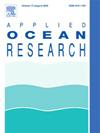Wave basin testing of hydrodynamic interactions in centralized controlled wave energy converter arrays for irregular short- and long-crested waves
IF 4.3
2区 工程技术
Q1 ENGINEERING, OCEAN
引用次数: 0
Abstract
To increase the total installed capacity, multiple wave energy converters (WECs) will be installed in an array configuration. Within these WEC arrays, hydrodynamic interactions occur and the sea state is modified accordingly. These WECs are equipped with a Power Take-Off (PTO) which converts the kinetic energy of the waves to mechanical energy. An optimal PTO can be obtained by setting the PTO control impedance equal to the complex conjugate of the intrinsic impedance of the WEC. Within a WEC array constituting of n closely spaced WECs, where hydrodynamic interactions between the WECs occur through radiation and diffraction of waves, the n x n PTO control impedance matrix should be equal to the complex conjugate of the n x n intrinsic impedance matrix. This paper discusses the incremental experimental modelling of five ‘WECfarm’ WECs: Modelling of the five isolated WECs, a two-WEC array, a three-WEC array, a four-WEC array, and a five-WEC array. System identification (SID) tests are performed to obtain an accurate dynamic model of the isolated WECs and the WEC arrays. Based on this model, causal impedance matching Proportional (P) controllers are designed, and tested for a selection of irregular long- and short-crested waves. This paper presents the dataset and results of the experimental campaign performed at the Coastal & Ocean Basin Ostend (COB), Belgium. With high measurement accuracy and repeatability, the presented dataset is reliable, while by considering controlled WECs, and operational and extreme wave conditions, it is realistic.
不规则短波峰和长波峰集中控制波能转换器阵列水动力相互作用的波盆试验
为了增加总装机容量,多个波浪能转换器(WECs)将以阵列配置安装。在这些WEC阵列中,水动力相互作用发生,海况相应地改变。这些WECs配备了一个动力输出装置(PTO),可以将波浪的动能转换为机械能。通过设置PTO控制阻抗等于WEC固有阻抗的复共轭,可以得到最优PTO。在由n个紧密间隔的wecc组成的WEC阵列中,wecc之间的水动力相互作用通过波的辐射和衍射发生,n x n PTO控制阻抗矩阵应等于n x n固有阻抗矩阵的复共轭。本文讨论了五种“WECfarm”wecc的增量实验建模:五种孤立wecc、两种wec阵列、三种wec阵列、四种wec阵列和五种wec阵列的建模。进行了系统辨识(SID)试验,获得了被隔离的WEC和WEC阵列的准确动态模型。基于该模型,设计了因果阻抗匹配比例(P)控制器,并对选择的不规则长峰和短峰波进行了测试。本文介绍了在海岸海岸进行的实验活动的数据集和结果。比利时奥斯坦德洋盆(COB)。由于具有较高的测量精度和可重复性,所提出的数据集是可靠的,而考虑到受控的WECs,以及操作和极端波浪条件,该数据集是现实的。
本文章由计算机程序翻译,如有差异,请以英文原文为准。
求助全文
约1分钟内获得全文
求助全文
来源期刊

Applied Ocean Research
地学-工程:大洋
CiteScore
8.70
自引率
7.00%
发文量
316
审稿时长
59 days
期刊介绍:
The aim of Applied Ocean Research is to encourage the submission of papers that advance the state of knowledge in a range of topics relevant to ocean engineering.
 求助内容:
求助内容: 应助结果提醒方式:
应助结果提醒方式:


